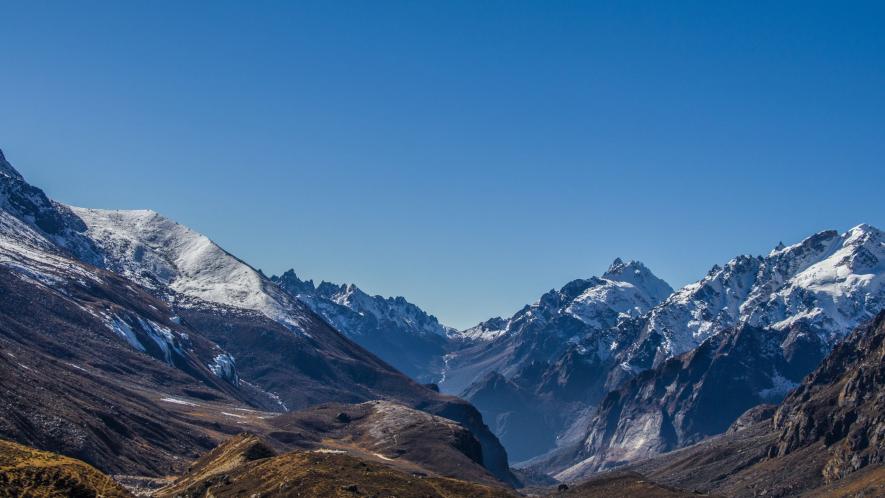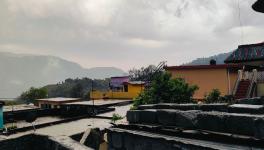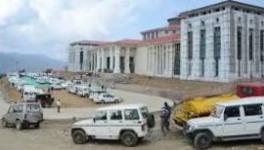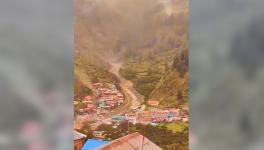Himalayas Need an Alternative Model, Financially as Well as Ecologically.

Image Courtesy: Wikimedia Commons
The two most pressing incidents in the Himalayas in the last few days have once again reinforced the basic argument that the current model of development in the Indian Himalayan Region(IHR) is not sustainable. These two incidents are as follows: the National Highway Char Dham Project tunnel caving in has led to more than 40 workers being trapped inside; the Shimla Kinnaur highway has been blocked for the last three days at Wangtoo.
These incidents have also brought another major factor to the forefront. The imminent necessity to ensure safety measures and protocols along with standard operating procedures to be followed whilst constructing such projects in the IHR. The incidents of 2023-floods in Himachal Pradesh and Uttarakhand, the Teesta River Dam tragedy, the Malana hydropower dam gates not opening, etc., all but raise a formidable standpost and that is about the development trajectory and the immediate necessity to intervene.
The Uttarkashi tunnel collapse of loose debris falling and blocking the main tunnel has once again brought to light the warnings that were issued by the geological and technical experts. They had raised questions on geological and geotechnical surveys for the project. It was pointed out that the accident spot is located near the main central thrust of the Himalayas.
Forty workers in the last five days have been trapped inside the tunnel in Uttarkashi district of Uttarakhand. The tunnel is located on the Yamunotri National Highway near Silkyara and is being constructed under the Char Dham Yatra Project.
The sheer paranoia about constructing this and other projects in the region has driven the cart to the extent that the scientific opinions of experts are either brushed aside or they are made scapegoats to work in tandem. Even the Supreme Court, which allowed the widening of the road, recommendations were not adhered to. One of the scientists has pointed out that massive use of explosives was used, and that could have triggered the caving in.
The Environment Impact Assessment is ridiculed. Take, for example, the Char Dham Project which is 889 kilometres long and should have a single EIA. Why? Because such an EIA will take into consideration the impact on the environment in a larger ecosystem and for sure will reveal realities that are not comfortable for such projects in the mountains. However, to avoid that happening, the single project was broken into 53 sections so that the EIA could be fragmented and very localised. Whereas the impact of this project is far from massive.
The other major problem is regarding the sheer obstinacy in accepting the fact that the Himalayas are the youngest range of mountains and are still in the formative stages. The geological and geotechnical studies, if at all were done, then what were the actions taken by the tunnel building company to avoid such incidents? We know the answer quite obviously.
The Main Central Thrust of the Himalayas passes a few kilometres north of the incident site, the scientists have pointed out in the past as well. Simply put, this means that this area is extremely sensitive to earthquakes, and frictional shear rocks are present in this area. Constructing in this zone is dangerous.
Kinnaur Incident
The National Highway from Shimla to Rekong Peo in Kinnaur has been blocked again at Wangtoo because of a massive landslide. The previous one, which was at Taranda that had blocked the same highway, was a few weeks ago. There are successive roadblocks taking place on this highway because of massive landslides.
Thanks to the hydropower construction work that has completely devastated the region and has frequently led to such incidents. Unscientific constructions in the ecologically fragile region of Kinnaur, depletion of forests and faulty planned structures near water streams are causing these landslides.
The uncontrolled construction of hydropower projects has transformed rivers into mere streams. Currently, there are 168 hydropower projects in operation in Himachal Pradesh, generating 10,848 MW of electricity, and the state, instead of taking a pragmatic and ecological viewpoint, is targeting 1,088 more hydropower projects by 2030 to harness some 22,640 MW of energy. The inevitability of disasters in the offing is for sure.
Safety Measures are Missing
The standard operating procedures must be upgraded time and again and should be followed in toto. However, what is seen in the past is that because of push from private players in the construction industry, the department or the agency responsible for ensuring safety measures was either disbanded or relegated to some tokenism. This was witnessed during the Wangtoo Karcham hydropower construction in Himachal Pradesh. The private player constructing this project was instrumental in the riddance of the safety department within the state electricity board responsible for quality and safety measures whilst constructing hydropower projects.
Likewise, in the construction of highways, and particularly the tunnel work, there must be an extreme exhibition of the safety measures ensuring there is no loss of lives. The Uttarkashi tunnel incident is a clear reminder of the fact that these measures were not taken into consideration.
However, there is an exception as well. And that is in the Atul tunnel construction work in the Kullu and Lahaul districts of Himachal Pradesh. The ‘Augusta’ company that was responsible for executing the construction work was extremely cautious in safety measures, and a slight chance of landslide or any other form of danger was dealt with very seriously. The company would not allow the workers to enter the tunnel unless all the protocols were followed and checked. This may even lead to some delay in the project timeline. But they adhered to principles of safety. The result is that in the entire construction period, not a single death occurred in tunnel work. That should be followed everywhere.
Alter the Financial Architecture
Arguing for a major disruption in the financial architecture of the IHR is important because, without that, the planned destruction of the Himalayas cannot be stopped. What does this mean? It means that the sheer impetus to use the Himalayas as a utility for profits in the forms of hydropower potential, tourism, mineral wealth, forest resources, etc., comes from the centre. The financial architecture that triggered such a paradigm began in the mid and late 90s when the IHR states were asked to manage their resources by themselves and look for avenues where they could attract capital investments.
The choice for these poor IHR states, which were carved out because of the aspirations of the mountain people and not because of their economic strength or financial viability, had very limited options. Almost all of them went into that trap and embarked on a path of selling their natural resources and utilising them at the behest of private and public companies. Not realising that the IHR is completely a different zone where the scope for such industrial activities is not just limited but also destructible.
And now, after almost three decades of embarking on this journey, the IHR is caught in a quagmire-financially as well as ecologically. The IPCC VI report has already forewarned of the massive vulnerability existing in this zone along with the increase in the frequency of disasters forecast.
The new financial architecture that the IHR must look into is about engaging with the upcoming XVIth Finance Commission and seeking a major disruption in the financial pattern of the region. This region must be considered with two major loops: ecologically sensitive zones, preservation of which is not only the only option but duty of mainland India, and altering the financial criteria, which is not based on demography but on the reality of the region and the needs of the people.
The writer is the former Deputy Mayor of Shimla, Himachal Pradesh. The views are personal.
Get the latest reports & analysis with people's perspective on Protests, movements & deep analytical videos, discussions of the current affairs in your Telegram app. Subscribe to NewsClick's Telegram channel & get Real-Time updates on stories, as they get published on our website.
























